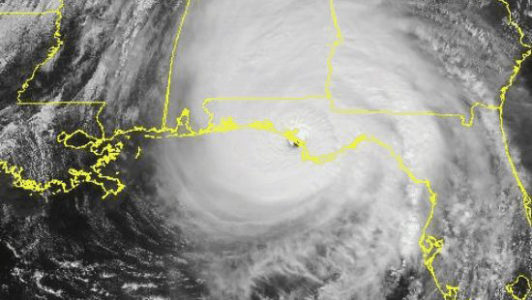National Hurricane Center(PANAMA CITY, Fla.) — A ferocious and historic Hurricane Michael is heading toward the Carolinas after tearing through Florida and Georgia, demolishing homes, submerging entire neighborhoods and killing at least two people, including an 11-year-old girl.
It is the third-most-powerful storm on record to hit the U.S., and the worst in nearly 50 years, since Hurricane Camille in 1969.
Michael, which is also the first Category 4 to ever make landfall on the Florida Panhandle, is also the “worst storm that the Florida Panhandle has ever seen,” Florida Gov. Rick Scott said Wednesday.
The massive storm hit the Panhandle early Wednesday afternoon, leaving a trail of devastation.
ABC News chief meteorologist Ginger Zee said the ruins in Mexico Beach were “eerily reminiscent to the scene I saw in Gulfport [Louisiana] in 2005” after the devastation of Hurricane Katrina.
The hurricane then roared north through southwest Georgia and was on Thursday setting its sights on North and South Carolina, states that are still reeling from historic flooding left by Hurricane Florence last month.
Michael takes aim on hard-hit Carolinas
Michael weakened to a tropical storm and was moving northeast Thursday, with tropical storm warnings in effect from Georgia to North Carolina, including Savannah, Raleigh, Wilmington and Charleston.
Six to 9 inches of rain could drench Virginia and North Carolina.
1st major hurricane to hit Georgia in 120 years
Michael is the first major hurricane to blow into the state since the 1898.
One death has been confirmed in Georgia. An 11-year-old girl was killed when part of a metal carport crashed into her family’s trailer in Lake Seminole and struck her in the head, local officials said.
Hundreds of thousands in the state were without power Thursday.
Seminole County is “pitch black,” in “complete and total devastation,” Travis Brooks, director of Seminole County’s Emergency Management Agency told ABC News.
Devastation in Florida
Michael, which Scott called “monstrous,” made landfall with wind speeds that were nearly the highest possible for a Category 4 — 155 mph. When a hurricane reaches 157 mph, it is a Category 5, the highest.
As the storm’s fierce winds pushed ocean water onto the Panhandle’s Mexico Beach, ABC News’ Ginger Zee said she saw an “entire home, a well-built home, rolling down the street. … It makes you shake.”
Michael left Mexico Beach destroyed, with the storm surge ripping multiple houses from their foundations, sending them bobbing along the main road that runs through the beloved beach town.
With cell service knocked out, leaving people isolated and staring at empty spots where dozens of homes are no longer standing.
The Panhandle is the wide strip of northwest Florida that touches the Gulf of Mexico and includes Alabama. Popular with tourists for its beaches, the area also has many year-round residents. Its largest city is Pensacola, with a population approaching half a million.
Thousands fled the Florida coastline before Michael hit. But by Wednesday morning, it was too late to evacuate. Those who remained were urged to shelter in place.
Krista Miller, who stayed behind in her 111-year-old home in Apalachicola Bay, Florida, told “Good Morning America,” “it sounded like a freight train coming from every direction.”
Colleen Swab, her mother and her young daughter took shelter in a closet in Panama City Beach, Florida.
“We were terrified but there was nowhere for us to go, we couldn’t get on the roads, it was too late,” Swab said. “I thought the roof was going to come off. I don’t suggest trying to ride out a storm.”
At least one person has died in Florida from the storm, according to local officials.
Residents in the dark
Michael has left about 648,000 households and businesses without power across Florida, Georgia, Alabama and South Carolina.
More than 30,000 workers from at least 24 states have been mobilized to restore power, officials said.
An estimated 325,000 residents in the path of the storm were told to evacuate by local authorities, but only 6,000 people came to the roughly 80 shelters across Florida, Alabama, Georgia and the Carolinas, officials said.
Federal officials were worried that the fast-moving nature of the storm didn’t give residents enough time to get out. Michael strengthened to a Category 4 in just a few hours.
Red Cross officials said they expect shelter population to swell to 20,000 by Thursday or Friday.
The storm “grew into a monster,” President Donald Trump said Wednesday from the Oval Office.
Despite the storm, Trump headed to his planned Wednesday night rally in Pennsylvania, telling reporters, “We have thousands of people lined up. … It would have been very unfair.”
Trump said later from the rally, “Our thoughts and prayers on behalf of the nation to everyone out there in the path of Hurricane Michael. … All of Pennsylvania and America sends its unwavering love and support.”
Trump said he is working closely with governors of Florida, Georgia, North Carolina, South Carolina and Alabama and Georgia to provide resources and support from the federal government.
Trump added, “I’ll be traveling to Florida very, very shortly, and I just want to wish them all the best. God speed.
Copyright © 2018, ABC Radio. All rights reserved.














